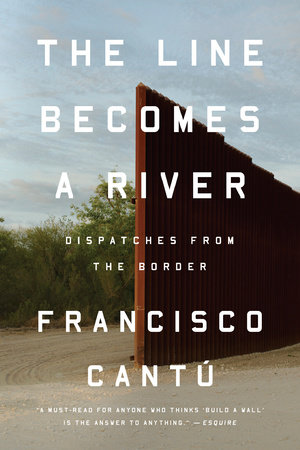The Line Becomes a River Reader’s Guide
By Francisco Cantú


1. “[T]he reality of the border is one of enforcement. I might not agree with every aspect of U.S. border policy, but there is power in understanding the realities it creates. Maybe after three or four years I’ll go back to school to study law, maybe I’ll work to shape new policies. If I become an immigration lawyer or a policy maker, imagine the unique knowledge I’ll bring.” Thus Cantú explains his decision to join the Border Patrol. He also says, “At least if I’m the one apprehending [border crossers], I can offer them some small comfort by speaking with them in their own language, by talking to them with knowledge of their home.” What do you think of these motivations? In retrospect, do they seem naive or overly idealistic? How are Cantú’s hopes and expectations changed by his experience?
2. “[S]tepping into a system doesn’t mean that the system becomes you,” Cantú insists to his mother in Part I of The Line Becomes a River. How does his time in the Border Patrol challenge that assertion? In what ways does “the system” determine, influence, and limit the behavior of the individuals within its ranks?
3. In interviews as well as in the author’s note to the paperback, Cantú has claimed that our border policy weaponizes the landscape. He writes, “It is a landscape often written off as a wasteland that is inherently ‘hostile’—without recognition that it has, in fact, been made to be hostile. Violence does not grow organically in our deserts or at our borders. It has arrived there through policy.” What does he mean by this, and how do we see this weaponization on display in The Line Becomes a River?
4. How is violence normalized along the border? What is the relationship between the casual, daily instances of violence Cantú witnesses and sometimes partakes in during his field work, the violence of the drug cartels in which he immerses himself when he gets promoted to a desk job, and, as he writes in the author’s note, “the threat that hovers ceaselessly over migrants, even long after they establish lives in a new country—a threat always poised to come knocking at the door”? How does one type of violence fuel the others? Do they receive different kinds of media attention? Different levels of empathy from the public? Why?
5. Consider the fact that José’s children never crossed the border. How was the border thrust into their lives, even though they are all U.S. citizens? Consider other ways the border is thrust into people’s lives, even after they cross it and settle into lives in the interior of the country.
6. “In places, commission reports remarked upon the ‘arbitrarily chosen’ nature of the boundary line and the ‘impracticable’ nature of their work,” Cantú writes, referring to those originally tasked with creating the U.S.-Mexican border. What geographical and political purposes does the border serve? What are the consequences of different kinds of demarcation (i.e., stone monuments vs. militarized walls)? How might we reframe the discussion around borders?
7. Cantú’s mother is a recurrent figure in the book. What role does she play in the narrative? How does her own life experience shape her perspective?
8. Cantú rarely tells us what he thinks or feels about the events he describes. Why do you think he makes that choice? What means does he use to create emotional and moral tension in the narrative? What is their effect?
9. During his time in the Border Patrol, Cantú watched countless people get deported, their names and details blurring in his mind, their stories incomplete. He encounters José after he has left the Patrol. Why do you think Cantú chose to include his story, and to end the book in the voice of José himself? What can the stories of individuals teach us about an issue, and how can we harness their power? Whose stories get amplified, and why? What can we do to amplify more voices, both at an individual and institutional level?
10. In his author’s note, Cantú acknowledges the ways he came to participate in a violent system/institution. Do you think Cantú bears any culpability for the work that he did? If so, does writing this book atone for any of it? What are concrete ways to “reject a culture of violence,” and how can we each take steps to “refuse to participate in it, and refuse to partake in its normalization?”
Just for joining you’ll get personalized recommendations on your dashboard daily and features only for members.
Find Out More Join Now Sign In